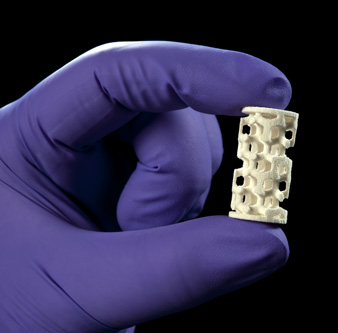Bone replacement by 3D printers

3D printed Bone fragment
Photo by Bundesanstalt für Material
3D printing can make the production of ceramic bone replacement structures possible. The ingredients are easily available: a special ceramic powder, a binder and a 3D printer. It is manufactured in a laboratory of the Federal Institute for Materials Research and Testing in Berlin. The layers are produced one by one by a commercially available 3D printer and then a powder developed by BAM is glued on at specified points according to the desired structure. Finally, the material has to be fired at about 1000 degrees Celsius – and the replacement bone is ready.
The resulting ceramic body has two interesting properties: firstly, 60 percent of it consists of pores. “On the other hand, the material can be absorbed by the body while the porous structure allows cells to grow into the scaffold” BAM project manager Cynthia Gomes says. The material is then gradually degraded by the body. Scientists have copied the configuration from nature: sponges or deer antlers have a similar bone structure.
Her idea for the future is that the doctor will scan the patient’s damaged area during surgery. The data will be immediately transferred to a computer that designs the spare part and immediately prints it using 3D printing while the patient is still in surgery. However, research is only at the early stages. The next step is to measure the solubility of the ceramic parts. For this purpose, an artificial body fluid is used while in another phase, together with a cooperation partner, cells are being grown.
Medical technology is just one of the fields of application for ceramics. Ceramic materials are being increasingly used in the automotive industry too. There, of course, non-degradability or compatibility are not the key issues but lightweight and at the same time, very stable structures are needed. How much strength must a ceramic component have in order not to fail must be regulated by a standard in the future. Currently, work is ongoing on this topic in which BAM is participating.
BAM can look back on 20 years of experience in biocompatible ceramic powder production. The powder’s particle size is adjusted so that it can flow in the bottle when shaken. Due to this specific characteristic layer thicknesses of just 100 micrometres are possible. The ceramic powder, with a composition patented by BAM, is being sold under license. One aim is to develop new equipment for production. 3D printing is still a relatively young technology. Experts speak of additive manufacturing and so far experiments on metals and plastics have been carried out. The use of ceramics however, is not yet widespread.
For more information, please visit: www.bam.de
News Categories
- » NEWS HOME
- » Automation & Robotics
- » Industry 4.0
- » Material Handling
- » Sensors
- » Quality & Testing
- » Machine Vision
- » Laser & Optics
- » Metalworking
- » Motion Control & Drives
- » Hydraulics & Pneumatics
- » Process Industry
- » Renewable Energy
- » Agriculture
- » Home & Office Furniture
- » Environmental Tech

